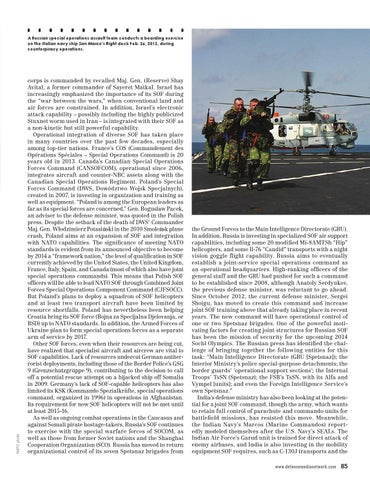NATO photo
A Russian special operations assault team conducts a boarding exercise on the Italian navy ship San Marco’s flight deck Feb. 26, 2013, during counterpiracy operations.
corps is commanded by recalled Maj. Gen. (Reserve) Shay Avital, a former commander of Sayeret Matkal. Israel has increasingly emphasized the importance of its SOF during the “war between the wars,” when conventional land and air forces are constrained. In addition, Israel’s electronic attack capability – possibly including the highly publicized Stuxnet worm used in Iran – is integrated with their SOF as a non-kinetic but still powerful capability. Operational integration of diverse SOF has taken place in many countries over the past few decades, especially among top-tier nations. France’s COS (Commandement des Opérations Spéciales – Special Operations Command) is 20 years old in 2013. Canada’s Canadian Special Operations Forces Command (CANSOFCOM), operational since 2006, integrates aircraft and counter-NBC assets along with the Canadian Special Operations Regiment. Poland’s Special Forces Command (DWS, Dowództwo Wojsk Specjalnych), created in 2007, is investing in organization and training as well as equipment. “Poland is among the European leaders as far as its special forces are concerned,” Gen. Boguslaw Pacek, an adviser to the defense minister, was quoted in the Polish press. Despite the setback of the death of DWS’ Commander Maj. Gen. Włodzimierz Potasiński in the 2010 Smoleńsk plane crash, Poland aims at an expansion of SOF and integration with NATO capabilities. The significance of meeting NATO standards is evident from its announced objective to become by 2014 a “framework nation,” the level of qualification in SOF currently achieved by the United States, the United Kingdom, France, Italy, Spain, and Canada (most of which also have joint special operations commands). This means that Polish SOF officers will be able to lead NATO SOF through Combined Joint Forces Special Operations Component Command (CJFSOCC). But Poland’s plans to deploy a squadron of SOF helicopters and at least two transport aircraft have been limited by resource shortfalls. Poland has nevertheless been helping Croatia bring its SOF force (Bojna za Specijalna Djelovanja, or BSD) up to NATO standards. In addition, the Armed Forces of Ukraine plan to form special operations forces as a separate arm of service by 2017. Other SOF forces, even when their resources are being cut, have realized that specialist aircraft and aircrew are vital to SOF capabilities. Lack of resources undercut German antiterrorist deployments, including those of the Border Police’s GSG 9 (Grenzschutzgruppe 9), contributing to the decision to call off a potential rescue attempt on a hijacked ship off Somalia in 2009. Germany’s lack of SOF-capable helicopters has also limited its KSK (Kommando Spezialkräfte, special operations command, organized in 1996) in operations in Afghanistan. Its requirement for new SOF helicopters will not be met until at least 2015-16. As well as ongoing combat operations in the Caucasus and against Somali pirate hostage-takers, Russia’s SOF continues to exercise with the special warfare forces of SOCOM, as well as those from former Soviet nations and the Shanghai Cooperation Organization (SCO). Russia has moved to return organizational control of its seven Spetsnaz brigades from
the Ground Forces to the Main Intelligence Directorate (GRU). In addition, Russia is investing in specialized SOF air support capabilities, including some 20 modified Mi-8AMTSh “Hip” helicopters, and some Il-76 “Candid” transports with a night vision goggle flight capability. Russia aims to eventually establish a joint-service special operations command as an operational headquarters. High-ranking officers of the general staff and the GRU had pushed for such a command to be established since 2008, although Anatoly Serdyukov, the previous defense minister, was reluctant to go ahead. Since October 2012, the current defense minister, Sergei Shoigu, has moved to create this command and increase joint SOF training above that already taking place in recent years. The new command will have operational control of one or two Spetsnaz brigades. One of the powerful motivating factors for creating joint structures for Russian SOF has been the mission of security for the upcoming 2014 Sochi Olympics. The Russian press has identified the challenge of bringing together the following entities for this task: “Main Intelligence Directorate (GRU [Spetsnaz]); the Interior Ministry’s police special-purpose detachments; the border guards’ ‘operational support sections’; the Internal Troops’ TsSN (Spetsnaz); the FSB’s TsSN, with its Alfa and Vympel [units]; and even the Foreign Intelligence Service’s own Spetsnaz.” India’s defense ministry has also been looking at the potential for a joint SOF command, though the army, which wants to retain full control of parachute and commando units for battlefield missions, has resisted this move. Meanwhile, the Indian Navy’s Marcos (Marine Commandos) reportedly modeled themselves after the U.S. Navy’s SEALs. The Indian Air Force’s Garud unit is trained for direct attack of enemy airbases, and India is also investing in the mobility equipment SOF requires, such as C-130J transports and the www.defensemedianetwork.com
85
